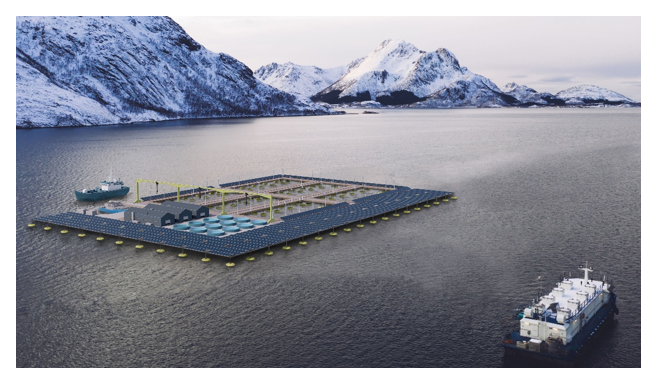FUTURE OF OFFSHORE-BASED CIRCULAR ECONOMY MARITIME PLATFORM FOR SUSTAINABLE FISH PRODUCTION
Introduction
This initiative envisions a scalable, offshore circular economy maritime platform for sustainable fish production, centered on a fully enclosed fish farming pool that ensures biosafety and environmental protection by isolating operations from the marine environment. Integrating all stages of aquaculture from hatchery to logistics, the platform includes living quarters and supply docks and is powered mainly by renewable energy. It tackles key challenges such as energy autonomy, nutrient recycling, and global scalability, offering a resilient, sustainable alternative to coastal aquaculture systems.
Vision
The envisioned platform redefines offshore aquaculture by introducing a circular, autonomous supply system operating entirely at sea. Central to this vision is the use of fully enclosed fish rearing pools that maintain complete separation from the ocean. These systems prevent any interaction with open water, thereby eliminating the risk of pathogen intrusion and ensuring there is no environmental degradation, such as seabed contamination from waste. The design allows for the integration of all stages of production—from hatchery to grow-out, processing, and logistics—into one self-sufficient system. Energy supply is almost entirely renewable, leveraging solar, wind, and wave energy, and supported by redundant backup systems for operational security.
System Architecture
The system architecture is based on a modular network of platforms designed for various operational functions. Production modules house enclosed liner pools, which support controlled exchange of seawater or freshwater, regulated feed content, and oxygenation. These are complemented by living and working modules that accommodate permanent on-site personnel. Docking stations enable the seamless arrival and departure of vessels for supply and transport. The entire infrastructure is powered by a hybrid renewable energy system composed of wind, wave, and solar sources. Backup diesel generators ensure the protection of livestock and maintain essential systems during unfavorable conditions.
Environmental Protection & Biosafety
At the heart of the environmental protection strategy is the use of an enclosed offshore liner pool that operates without any direct exchange with surrounding sea water. This design creates a robust barrier against pathogens and external contamination, ensuring biosecure conditions for fish farming. Furthermore, internal wastewater treatment systems and the ability to monitor and adjust water parameters result in minimal environmental footprint. The platform protects natural ecosystems by avoiding contact with marine life and eliminating waste discharge into the ocean. These features also significantly reduce the need for antibiotics or medications, enabling organic aquaculture practices.
Development Priorities
Key development priorities focus on building scalable, energy-autonomous offshore platforms that integrate diverse systems into a coherent whole. This includes advancing biosafe aquaculture technologies that ensure environmental isolation while enabling controlled rearing conditions. The integration of energy, supply logistics, housing, and food processing into a single marine facility is a complex challenge, demanding interdisciplinary innovation. Additionally, minimizing waste through a circular economy approach—such as the on-site generation of fertilizers and complete resource utilization—remains a central goal.
Global Relevance
This offshore platform model presents a globally relevant solution to the increasing strain on coastal environments. By moving sustainable fish production into offshore zones, it alleviates pressure on nearshore ecosystems and supports global food security. The design is particularly suitable for deployment in regions facing climate stress or lacking adequate coastal infrastructure. Its adaptability allows for use even in tropical zones by employing technologies for controlled oxygenation and thermal regulation. Overall, it sets a precedent for next-generation marine food systems that are sustainable, resilient, and ecologically responsible.
